Schedule Your Consultation with Dr. Prasad Here
- Home
- About Dr. Prasad
- Face & Eyes
Eyelifts
- Eyelid Surgery
- Eye lift Before and After Photos
- Asian Eyelid Surgery
- Upper Eyelid Surgery
- Upper Eyelid Hollow / Lower Brow Hollowing
- Under Eye Bag Surgery
- Eyelid Ptosis Surgery
- Transconjunctival Blepharoplasty
- Under Eye Fillers
- Eyelid Surgery Revision Specialist
- Thyroid Eye Disease
- Tear Trough Implants
- Eye Lift Questions and Answers
- Body
- Injectables
- Laser
- Hair Restoration
- Photos
- Hair Restoration Before and After Photos
- Eye lift Before and After Photos
- Upper Blepharoplasty Before and After
- Ptosis Surgery Before And After
- Facelift Before and After Photos
- Lip Enhancement Before and After Photos
- Under Eye Filler Before and After
- Blepharoplasty Before and After
- Lower Blepharoplasty Before and After Photos
- Eyelid Surgery Before and After
- Double Eyelid Surgery Before and After
- Contact Us
- Home
- About Dr. Prasad
- Face & Eyes
Eyelifts
- Eyelid Surgery
- Eye lift Before and After Photos
- Asian Eyelid Surgery
- Upper Eyelid Surgery
- Upper Eyelid Hollow / Lower Brow Hollowing
- Under Eye Bag Surgery
- Eyelid Ptosis Surgery
- Transconjunctival Blepharoplasty
- Under Eye Fillers
- Eyelid Surgery Revision Specialist
- Thyroid Eye Disease
- Tear Trough Implants
- Eye Lift Questions and Answers
- Body
- Injectables
- Laser
- Hair Restoration
- Photos
- Hair Restoration Before and After Photos
- Eye lift Before and After Photos
- Upper Blepharoplasty Before and After
- Ptosis Surgery Before And After
- Facelift Before and After Photos
- Lip Enhancement Before and After Photos
- Under Eye Filler Before and After
- Blepharoplasty Before and After
- Lower Blepharoplasty Before and After Photos
- Eyelid Surgery Before and After
- Double Eyelid Surgery Before and After
- Contact Us
Laser Facial Skin Tightening
Non-surgical skin tightening procedures are continuously growing in popularity. The idea is to apply a specific amount of heat from a laser device to cause the skin to contract and to induce a collagen production response.
The standard for skin tightening was full beam Erbium or CO2 lasers where the top layer of skin was removed while simultaneously applying heat to the deeper layers of the skin. Although consistently successful at improving the appearance of skin, long healing time and complications like scarring, skin pigment changes limited who would be a good candidate for this type of procedure.
New methods using the Erbium and CO2 lasers in a fractional or fractionated method have made these procedures more convenient. Fractional technology can be customized to spare the top layer of skin, or the epidermis, by using columns of laser energy to reach the dermis (the backbone of the skin) for the desired effect. The dermis is where collagen is generated, and where the skin contracts and tightens.
Although more safe and predictable, fractional lasers need to be done by trained and experienced physicians who know how to apply the right amount of laser energy to be effective and minimize risks and complications which often occurred with full beam lasers when used by inexperienced practitioners.
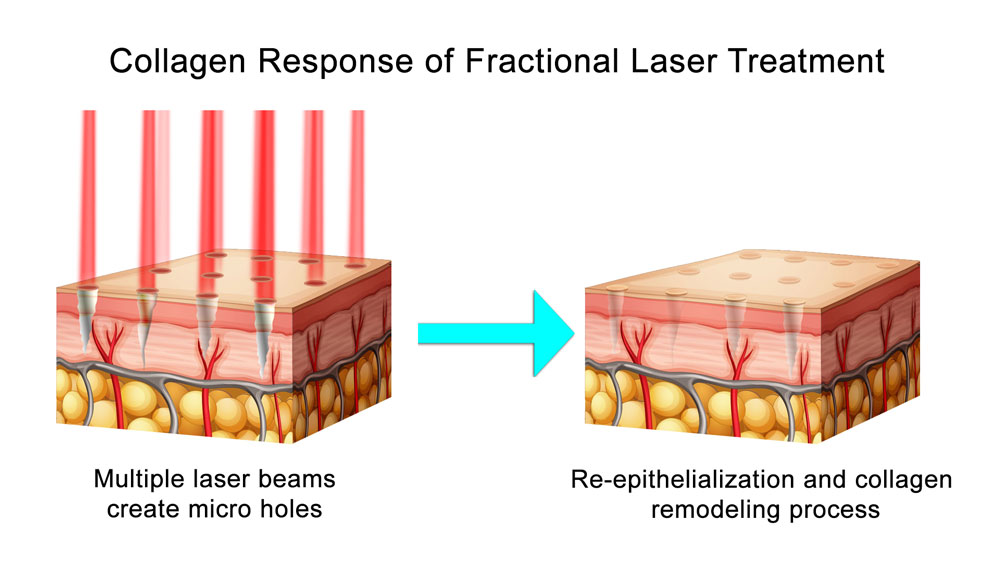
OF THE SKIN (DERMIS) TO HEAT IT, WITH THE BODY RECOGNIZING IT AS AN INJURY. THE BODY’S REACTION TO THE INJURY IS TO
GENERATE MORE COLLAGEN TO HEAL THE SKIN AND TIGHTEN IT, GIVING IT A MORE YOUTHFUL QUALITY.
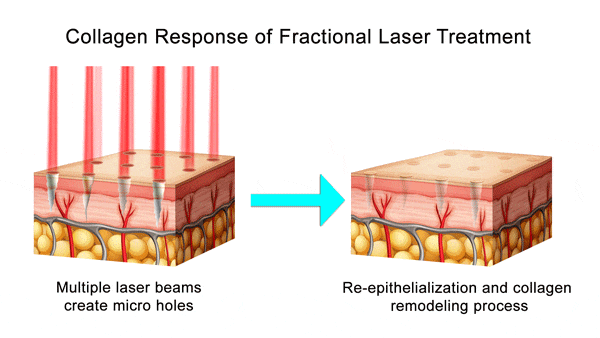
OF THE SKIN (DERMIS) TO HEAT IT, WITH THE BODY RECOGNIZING IT AS AN INJURY. THE BODY’S REACTION TO THE INJURY IS TO
GENERATE MORE COLLAGEN TO HEAL THE SKIN AND TIGHTEN IT, GIVING IT A MORE YOUTHFUL QUALITY.
Fully Ablative Laser Skin Resurfacing
Fully ablative laser skin resurfacing is frequently used for skin renewal and tightening of facial skin. The laser is used to take off the top layer of skin, or the epidermis, so a new, fresh layer of skin will come in. In addition the laser treatment induces skin contraction and additional collagen formation in the dermis.
The collagen response results from heating the dermis (the deeper skin layer below the surface layer called the epidermis) so the bonds that hold collagen together breakdown in a process called collagen denaturing. The body responds to the breakdown of collagen as an injury, so it reacts by generating new collagen, which once healed, gives skin a more youthful quality.
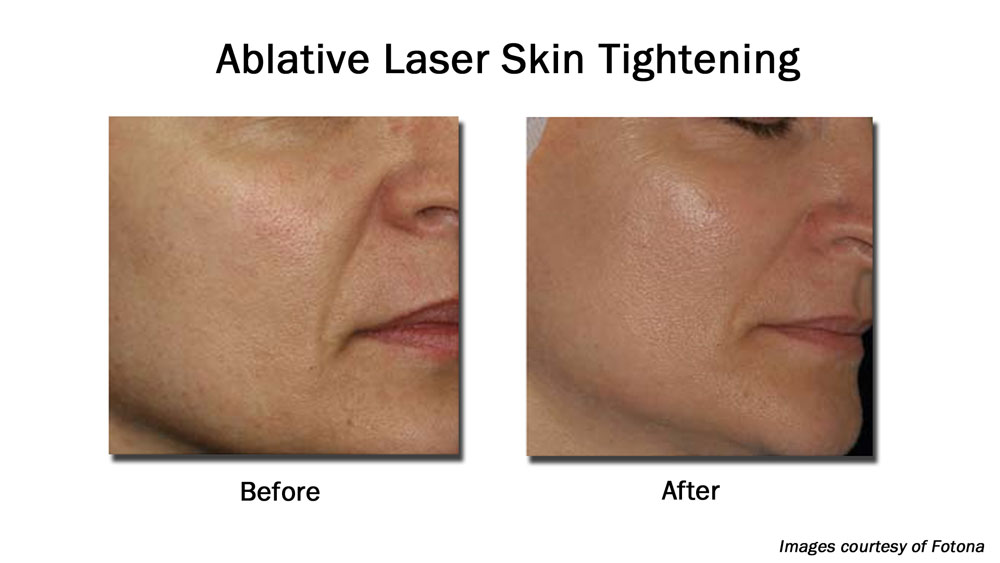
WHILE STIMULATING COLLAGEN PRODUCTION AND CONTRACTION/TIGHTENING IN THE SKIN’S BACKBONE (DERMIS).
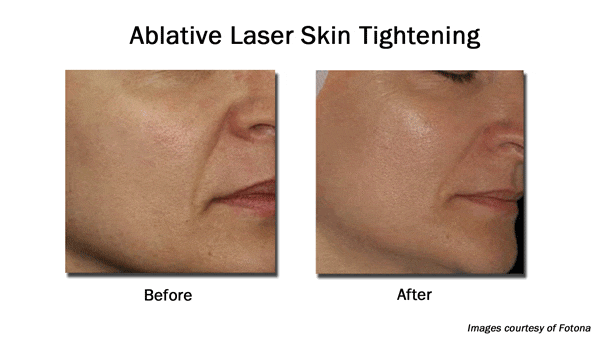
WHILE STIMULATING COLLAGEN PRODUCTION AND CONTRACTION/TIGHTENING IN THE SKIN’S BACKBONE (DERMIS).
Risks of Complications Reduced with Gradual, Controlled Heat, and Adjustable Laser Beams
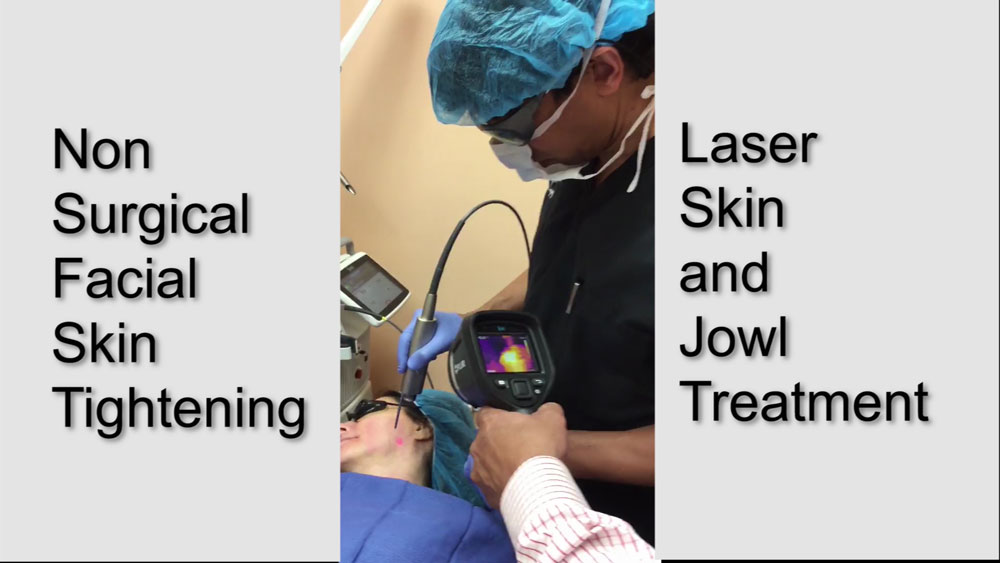
MAKING IT A SAFE, COMFORTABLE, AND FAST PROCEDURE FOR THE PATIENT, WHILE GIVING LASTING RESULTS.
While risks were reduced with the transition of full beam lasers to fractionated lasers, complications were still persistent with improper and overuse of fractionated lasers, especially when lasers are used in an attempt to replace cosmetic surgeries. The next generation of medical lasers took another step to provide the practitioner more control, and provide more comfort to the patient by limiting heat and the discomfort associated with high skin temperature. Lasers such as the new SP Dynamis Pro features Nd:YAG and Erbium lasers that reduce risks even further with:
- greater temperature and energy control
- more gradual heating of the skin layers
- more options in controlling beam wavelength for precision
- customized treatment without overheating
- multiple modes to adjust levels of skin peeling, ablation, tightening, and resurfacing.
Non-Ablative Laser Facial Resurfacing

THE BACKBONE OF THE SKIN (DERMIS) IS PENETRATED WITH HEAT AND TIGHTENED,
AND STIMULATED TO PRODUCE MORE COLLAGEN, BUT WITH LITTLE TO NO RECOVERY TIME LIKE A FULLY ABLATIVE PROCEDURE.
Non-ablative laser facial resurfacing is a major step in quick recovery skin rejuvenation. Patients can recover with virtually no downtime and no redness. Non-ablative skin tightening can be performed using the FRAC3 setting of the ND:Yag laser in the SP Dynamis laser. FRAC3 uses short pulse duration with high power to contract skin and trigger a collagen response – without downtime.
FRAC3 non-ablative skin tightening works by focusing its energy on “islands” of the epidermis and dermis, so the surrounding skin tissue of the treatment area is not heated or ablated. The skin is still heated to induce a collagen response which results in tightening of the dermis at the same time avoiding affecting the protective layer of the skin (epidermis) so extended downtime and prolonged recovery are avoided.
Ablative vs Non-Ablative Laser Resurfacing
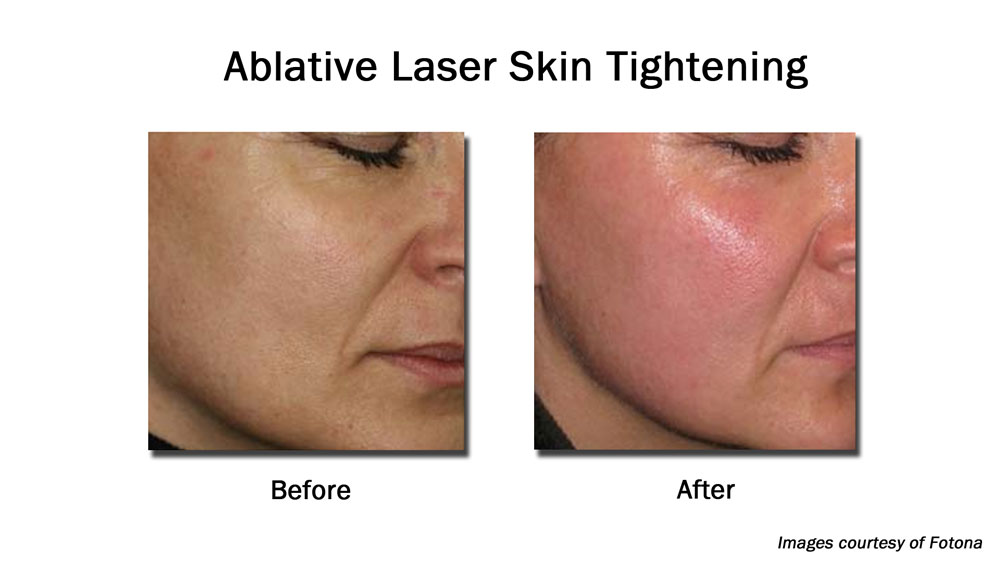
OF THE TOP LAYER OF SKIN, BUT IS MORE THOROUGH IN SKIN (EPIDERMIS) RENEWAL, AND MAXIMIZES COLLAGEN
STIMULATION AND TIGHTENING OF THE DERMIS. FULL ABLATION REMAINS THE STANDARD OF LASER SKIN SKIN TIGHTENING.
Generally, ablative laser skin resurfacing is the most thorough skin tightening method, and provides the best results for firmer, smoother, and tighter skin. However, ablation means that the protective layer of the skin, the epidermis, is temporarily compromised while healing and new collagen formation is ongoing, which leaves the skin looking pink to a light red during the recovery/ collagen formation process. The general rule of laser treatment is the deeper it penetrates the dermis, the better the results, but recovery time is also increased.
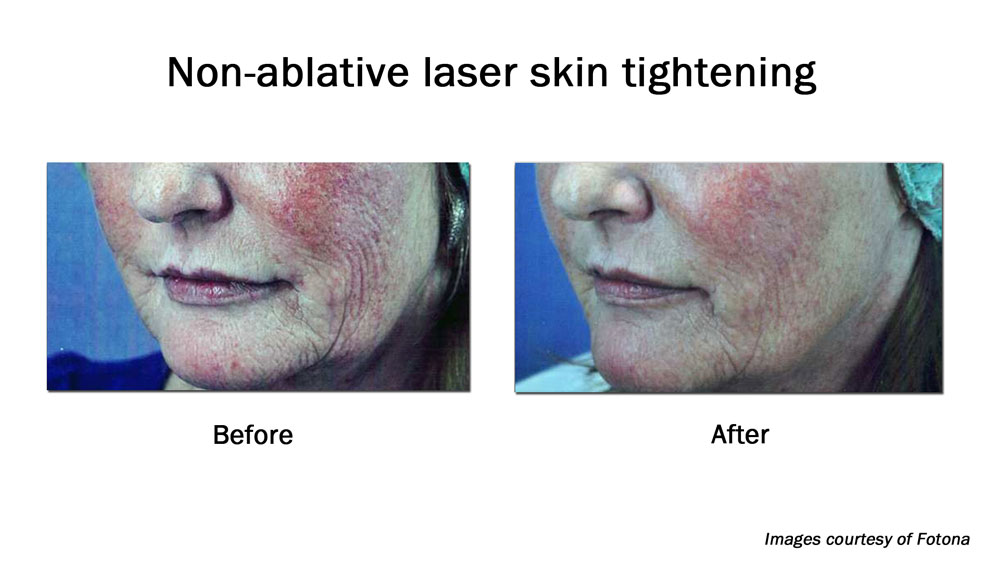
THE SKIN, WITHOUT REDNESS OR PROLONGED RECOVERY AS THE TOP LAYER OF SKIN IS NOT ABLATED.
Non-ablative laser skin resurfacing is often recommended during summer months when sun exposure is higher, or when someone wants to tighten skin close to a social deadline, like a wedding. Non-ablative laser treatment is also useful for skin imperfections such as pigmentation. If people want little to no downtime, then non-ablative skin tightening is still an effective option as heat still tightens the dermis and generates collagen, but the outer layer of skin (epidermis) doesn’t have the same prolonged redness as the ablative option.
Caution with Thermal Energy Devices
Excessive use of heat or prolonged exposure to thermal energy devices can result in inadvertent loss of fat below the skin which creates youthful volume. Other complications include skin burn, blistering, scarring, and prolonged redness. Laser manufacturers recommend a doctor with extensive training with lasers perform these procedures to minimize these potential risks.

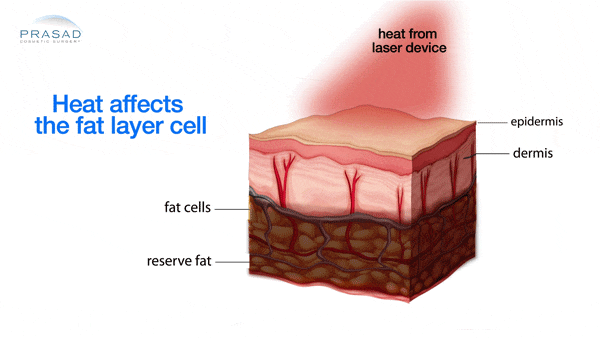
LASER SKIN TIGHTENING WORKS BY PRIMARILY HEATING THE DERMIS TO TIGHTEN AND INCITE A COLLAGEN PRODUCTION RESPONSE.
PROLONGED EXPOSURE OR EXCESSIVE HEAT CAN “COOK” THE ESSENTIAL FAT BENEATH THE DERMIS, AND DAMAGE THE SKIN LAYERS.
Nd:YAG Laser Treatment
The Nd:YAG laser and other therapies can be performed for non-surgical fat loss. In the face, fat loss should be minimized as a small layer of fat gives facial skin a youthful volume and the fat layer also provides physiologic functions for skin for general health and a visible glow. The Nd:YAG laser technology can be focused to improve undesirable fat collection in the face such as the area under the chin and the jowls.
Facial Skin Tightening as a “Lunchtime Procedure”
Skin tightening is a quick, outpatient procedure that can be done during lunch hour. A whole cheek can be tightened to treat wrinkles in just a few minutes. Skin tightening for the whole face can take less than 30 minutes.
Contact us today for facial skin tightening at our Manhattan, New York City location or Garden City, Long Island by filling out the contact form below.
